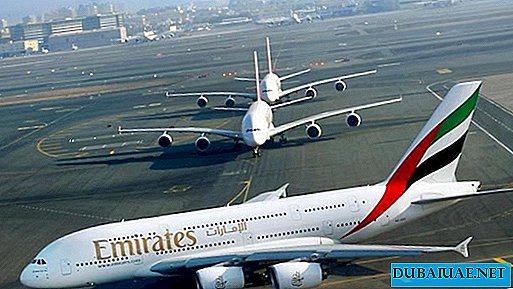 ULTRA-MODERN TRAIN CARRYING PASSENGERS BY PIPELINE AT SOUND SPEED, KNOWN AS HYPERLOOP, WILL ALLOW ALLOW TO MOVE FROM ABU DABI TO DUBAI IN 12 MINUTES, AND FROM THERE TO FUJEIRA IN 10. ALSO AFTER SOME TIME, "HYPERPETLINE" WILL COMBINE THE LINE THROUGHOUT THE ANNOUNCEMENTS ALREADY A TELL. THE MOST IMPORTANT THAT NEXT LOCAL RESIDENTS ARE WORNING WHERE THE STATIONS WILL ORDER THAT, OR IF USING THE TERMINOLOGY OF THE DEVELOPERS, PORTALS.
ULTRA-MODERN TRAIN CARRYING PASSENGERS BY PIPELINE AT SOUND SPEED, KNOWN AS HYPERLOOP, WILL ALLOW ALLOW TO MOVE FROM ABU DABI TO DUBAI IN 12 MINUTES, AND FROM THERE TO FUJEIRA IN 10. ALSO AFTER SOME TIME, "HYPERPETLINE" WILL COMBINE THE LINE THROUGHOUT THE ANNOUNCEMENTS ALREADY A TELL. THE MOST IMPORTANT THAT NEXT LOCAL RESIDENTS ARE WORNING WHERE THE STATIONS WILL ORDER THAT, OR IF USING THE TERMINOLOGY OF THE DEVELOPERS, PORTALS.
1100 km / h - this speed can be developed by ground public transport today. Almost the speed of sound (1,192 km / h), a cross between the bullets from the Colt M 1900 and Walther PP Super, the MiG-15 fighter jets and the Dasso Mirage. To do this, you do not need so much - just hide the train in the pipe, having previously pumped air out of it. There is some similarity with airmail, only containers with “letters” this time will be equipped with a turbo engine and magnetic suspension.
Once again, we owe the idea to Elon Musk, creator of the PayPal payment system, the Tesla electric vehicle and the Space X space project. In California, such a train will connect San Francisco with Los Angeles in the 2020s. Russia plans to lay Hyperloop routes from Moscow to Sochi. In October 2016, the head of the Dubai Emirate's Roads and Transport Committee, Mattar Al Thayer, signed an agreement on the organization of a passenger transportation network with Hyperloop One CEO Rob Lloyd. A month earlier, the same company received $ 50 million from the developer of the DP World Group island archipelago project for the creation of an underwater vacuum cargo delivery line from the mainland.
 Crowdsourcing plus
Crowdsourcing plus
The prospect of the "vacuum express" is proved first of all by the fact that several companies are now independently developing each other at once. This is, firstly, Space X Elon Musk, who in 2012 announced an alternative to the expensive California High-Speed Rail project. The entrepreneur proposed the idea of passenger capsules moving in a pipeline with an intensity of metro trains and a speed of 230 km / h, while being powered by solar energy. Musk publicly refused to develop the capsule itself, but put in a free access 58-page "alpha version" of the project concept. After the success of competitors who picked up the idea at the end of 2015, Elon decided to return to the development of Hyperloop. Space X has now announced an open competition for the best design of the passenger module. The company itself is constructing a test track 1.5 km long and 1.8 m in diameter in the California Hotthorne.
The appearance of the "alpha version" in August 2013 interested Jack Albborn, the founder of the crowdsourcing portal Jumpstarter. He registered the company Hyperloop Transportation Technologies (NTT) in the USA and commissioned a software model based on the Mask concept to the software developer ANSYS. The simulation results showed that it is quite possible to build a vacuum train with existing technologies, the question was raised on Jumpstarter, where 300 people voted for the new vehicle. After that, Alborne began to recruit a team on an ad hoc basis - from volunteers who agreed to work on pure enthusiasm in the hope of future profit. Today, NTT employs about 500 people from Cisco, Boeing, Harvard and other places, including the world's oldest developers of vacuum technologies Aecom and Oerlikon and the architectural bureau from L.A. - Suprastudia. In 2015, the company entered an IPO, where it was valued at $ 100 million, and built an 8-kilometer test "passenger pipeline" in California.
 In March 2016, NTT signed an agreement with the Slovak government to develop a project for the construction of the Vienna-Bratislava-Budapest highway. The project is estimated at 200-300 million dollars, the Indutrack train will use the principle of magnetic levitation. "The new vehicle, when moving through the pipeline, will in fact have no speed loss due to friction and air resistance," explains NTT Executive Director Bebop Gresta. "There, in the pipe, there will be not absolute vacuum, but rarefied air suitable for operation of turbochargers."
In March 2016, NTT signed an agreement with the Slovak government to develop a project for the construction of the Vienna-Bratislava-Budapest highway. The project is estimated at 200-300 million dollars, the Indutrack train will use the principle of magnetic levitation. "The new vehicle, when moving through the pipeline, will in fact have no speed loss due to friction and air resistance," explains NTT Executive Director Bebop Gresta. "There, in the pipe, there will be not absolute vacuum, but rarefied air suitable for operation of turbochargers."
An investor in the Uber project and a sponsor of the US Democratic Party, Iranian Sherwin Pishevar, took a different path, having founded Hyperloop Tech with the moral support of Barack Obama. Initially, the company huddled in the garage of the technical genius Kevin Brogan, who was lured from Space X. On this occasion, the engineer even changed his name to Brogan Bembrogan. Now Brogan Bembrogan has already quit and is suing employers, but he managed to do the most. Initially, an airbag was planned for the hyperspot, but this idea was abandoned in 2015. On May 12, 2016, a prototype train with an active (unlike Indutrack) magnetic suspension passed successful tests in Nevada, accelerating to 180 km / h. Sherwin Pishevar’s company, whose board included Sultan Ahmed bin Sulayem, has now changed his name to Hyperloop One - to avoid confusion with NTT. To adapt the project to the conditions of the infrastructure of the United Arab Emirates, the Danish architectural bureau Bjarke Ingels Group (BIG), known for the projects of the "anti-skyscraper" in Kuala Lumpur, the observation tower in Arizona, the art center in Utah, the drill-like high-rise in Vancouver and many others, was invited as a partner more interesting than that. In November 2016, the Hyperpetli design concept, which allows moving from Abu Dhabi to Dubai and back in a revolutionary new transport style, was ready.
 Georeferencing
Georeferencing
If we make good money with our minds, the time spent on transportation delays becomes simply a pity. This greed of creative specialists has long been the cause of office contention about booking the right slot at the airport, gave a start to the life of the ideology of working in remote access, and ensured the development of private aviation and video conferencing technologies. Teleportation is not far off - due to the development of previously disgraced quantum mechanics. But quantum teleportation has one problem: will we put everything together from the original personality at the endpoint of the route? In the meantime, Hyperloop technology and its adaptation project in the Emirates from BIG offer not to wait for favors from nature, but to competently take advantage of what already exists.
An expensive company professional no longer needs to harass receptionists with ticket requests. It is enough to activate the Uber application once again on a smartphone, form a route and formulate preferences - a booth for relaxation, a conference or a gym. The maximum passenger capacity of such a cabin is six people. A robotic taxi will arrive, but this time it will not be an ordinary electric car, but a mirror-shaped cube pod without windows, but with a video screen all over the wall. A few minutes around the city to the nearest Hyperloop portal. According to the scheme adopted today, such portals will be located at the foot of the Bourges Khalifa, in Dubai Marina and the nearest airports. You don’t need to go out, you can still sleep, train, prove your point by switching slides on the screen presentation. The logistics program of the portal, meanwhile, is taxiing the cab along with three more hyper-trains of the same cylindrical shape. Almost imperceptibly due to high-quality sound insulation, the front and rear "covers" of the composition-cylinder fall into place. There is a turbo engine in the front, and batteries in the back.
Each portal gives an understanding of the term “hyper loop” - a train moving along a straight pipeline with transonic speed smoothly brakes on the final lap. In Dubai, at the foot of the Burj Khalifa skyscraper, this circle will be multi-tiered. In Abu Dhabi, a portal located near the Etihad Towers will be wider in diameter - about half a kilometer. The pipeline is two-thread, due to this scheme, the waiting time for the slot is really reduced to the level of metro trains. The signal for departure, the next stop is Al Maktoum Airport. The hyper train smoothly picks up its 1,100 km per hour. This is the speed proposed by BIG, but in fact Hyperloop One provides 1200 or more, but on the scale of local distances this is already superfluous. A steel pipeline laid over deserts on energy-intensive concrete piers buzzes and scares away camels, vainly counting on its threadlike shadow under the hot sun.
Outwardly, the mirrored passenger cabin still automatically drives out of the train to Abu Dhabi, leaves the portal to city avenues, Uber navigation is connected, a few minutes later - and the creative specialist is already at the end of the route.
If you are lucky and the office with the house are in close proximity to the portals, you can ignore this time. Someone will say that you can fly just as quickly by helicopter, but you need to get out of the car, bend down under the propeller, feel fear at the height and boredom in the storage terminals. An airplane in such regional significance transfers is not a competitor at all. It would take much more time to register a flight and taxi to take off with all the ensuing delays.

Expense item
The first Hyperloop train on the Dubai - Abu Dhabi route will go in 2021. According to preliminary estimates by McKinsey, construction will cost customers $ 40 million per kilometer of track. This is about half the price of a subway or ground rail. The portals Bourge Khalifa and Dubai Marina will connect a kind of branch-looping to the main pipeline, if we use oil and gas terminology. The main pipe will pass through three airports - Abu Dhabi, Al Maktoum and Dubai. A ticket for a new vehicle, taking into account the services of Uber, will cost as much as a ticket for a bus, as developers from Hyperloop One promise. At the same time, the time spent on travel compares favorably with all possible alternatives. “We don’t sell vehicles, we give time,” says Josh Giguel, head of engineering at Hyperloop One. “Hyper-speed combined with efficient use of time set a new standard for travel.”
"Hyperloop is also able to change the mentality of megacities," adds BIG founder Bjarke Ingels.
To date, 19 countries have become interested in the construction of Hyperlоop routes. As we can see, there are enough orders for all companies working in this direction, and the results will not be long in coming. The vacuum express and its adaptation to the conditions of each of the cities is a good example of not only the development of separate technologies, but their successful convergence. All this makes it possible to talk about a truly new and in many ways revolutionary form of transport communication, which we are already witnessing the birth and development of today.
Text: Dmitry Konstantinov








